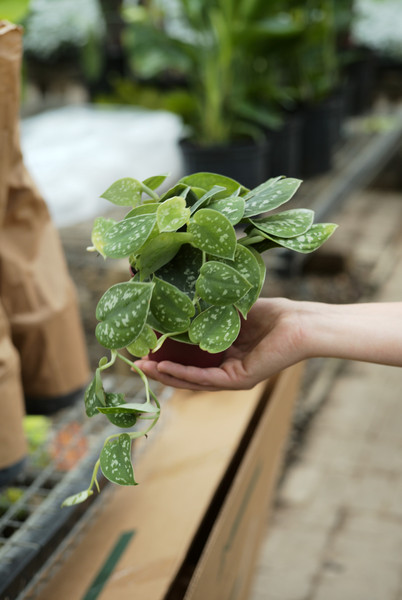Scindapsus pictus exotica
Posted by Hannah Brand on Sep 2nd 2024
Weekly Plant Chat: Scindapsus pictus exotica
Hey Plant Friends!
This week we are talking about Scindapsus pictus ‘Exotica’, more commonly known as Silver Satin Pothos. This beautiful houseplant is known for its large, heart shaped, silvery-green leaves and easy care. Scindapsus are a great hanging plant because of their trailing habit.
Family of Origin
Scindapsus pictus ‘Exotica’ belong to the Araceae or aroid plant family along with monstera, peace lilies, and philodendron. This particular Scindapsus is native to Bangladesh, Borneo, Java, Malay, Peninsular Malaysia, Philippines, Sulawesi, Sumatra, and Thailand. In the environment, Scindapsus grows as an epiphyte (a plant that grows on another plant, but is not parasitic), climbing up tree trunks.
Plant Care
Light
Scindapsus grows vigorously in bright or medium light. Some varieties do tolerate low light, but their color may dull, or variegation may fade. Too much sun may burn the foliage. If you plan to have your plant outside for the summer a nice shady spot is great.
Soil
Scindapsus, like all aroids, they like a chunky, airy mix. We recommend using Sol Soils House Plant Chunky Mix. This mix includes perlite, pumice, coconut husks, pine bark, and more to achieve the perfect balance of aeration, drainage, and water holding capacity.
Water
Scindapsus will show you they are thirsty by curling their leaves inward. Water when the top 2”-3” inches of soil are dry to the touch then give your plant a good soak. Cut back during the winter months to avoid root rot.
Fertilizer
Fertilize with an all purpose fertilizer. We recommend Schultz All Purpose Liquid Plant Food. As growth slows in the winter months, fertilize at half strength.
Hot Tips
Keep an eye out for common pests such as mealy bugs and spider mites. Check for pests weekly while watering and keep a bottle of Bonide’s Insecticidal Soap on hand for easy treatment
Scindapsus is toxic to cats and dogs.
Shop Now!
Always approachable and happy to help!

